Practical Synthesis of 7-Bromo-4-chloro-1H-indazol-3-amine: An Important Intermediate to Lenacapavir
Abstract
:1. Introduction

2. Results
2.1. Synthesis of 3-Bromo-2,6-dichlorobenzonitrile
2.2. Synthesis of 7-Bromo-4-chloro-1H-indazol-3-amine
3. Experimental Section
3.1. General Method
3.2. Chemistry
3.2.1. Preparation of 3-Bromo-2,6-dichlorobenzonitrile (8)
3.2.2. Preparation of 7-Bromo-4-chloro-1H-indol-3-amine (6)
4. Conclusions
Supplementary Materials
Author Contributions
Funding
Institutional Review Board Statement
Informed Consent Statement
Data Availability Statement
Acknowledgments
Conflicts of Interest
References
- Lesuisse, D.; Dutruc-Rosset, G.; Tiraboschi, G.; Dreyer, M.K.; Maignan, S.; Chevalier, A.; Halley, F.; Bertrand, P.; Burgevin, M.-C.; Quarteronet, D.; et al. Rational Design of Potent GSK3β Inhibitors with Selectivity for Cdk1 and Cdk2. Bioorg. Med. Chem. Lett. 2010, 20, 1985–1989. [Google Scholar] [CrossRef] [PubMed]
- Fukuda, T.; Ueda, K.; Ishiyama, T.; Goto, R.; Muramatsu, S.; Hashimoto, M.; Watanabe, K.; Tanaka, N. Synthesis and SAR Studies of 3,6-Disubstituted Indazole Derivatives as Potent Hepcidin Production Inhibitors. Bioorg. Med. Chem. Lett. 2017, 27, 2148–2152. [Google Scholar] [CrossRef] [PubMed]
- Kansal, N.; Silakari, O.; Ravikumar, M. Three Dimensional Pharmacophore Modelling for C-Kit Receptor Tyrosine Kinase Inhibitors. Eur. J. Med. Chem. 2010, 45, 393–404. [Google Scholar] [CrossRef] [PubMed]
- Link, J.O.; Rhee, M.S.; Tse, W.C.; Zheng, J.; Somoza, J.R.; Rowe, W.; Begley, R.; Chiu, A.; Mulato, A.; Hansen, D.; et al. Clinical Targeting of HIV Capsid Protein with a Long-Acting Small Molecule. Nature 2020, 584, 614–618. [Google Scholar] [CrossRef] [PubMed]
- Bester, S.M.; Wei, G.; Zhao, H.; Adu-Ampratwum, D.; Iqbal, N.; Courouble, V.V.; Francis, A.C.; Annamalai, A.S.; Singh, P.K.; Shkriabai, N.; et al. Structural and Mechanistic Bases for a Potent HIV-1 Capsid Inhibitor. Science 2020, 370, 360–364. [Google Scholar] [CrossRef] [PubMed]
- Kruger, A.W.; Rozema, M.J.; Chu-Kung, A.; Gandarilla, J.; Haight, A.R.; Kotecki, B.J.; Richter, S.M.; Schwartz, A.M.; Wang, Z. The Discovery and Development of a Safe, Practical Synthesis of ABT-869. Org. Process Res. Dev. 2009, 13, 1419–1425. [Google Scholar] [CrossRef]
- Lefebvre, V.; Cailly, T.; Fabis, F.; Rault, S. Two-Step Synthesis of Substituted 3-Aminoindazoles from 2-Bromobenzonitriles. J. Org. Chem. 2010, 75, 2730–2732. [Google Scholar] [CrossRef] [PubMed]
- Bandiera, T.; Lombardi, B.A.; Nesi, M.; Perrone, E.; Bossi, R.; Polucci, P. Indazole Derivatives as Kinase Inhibitors for the Treatment of Cancer. WO2008074749A1, 26 June 2008. [Google Scholar]
- Burke, M.J.; Trantow, B.M. An Efficient Route to 3-Aminoindazoles and 3-Amino-7-Azaindazoles. Tetrahedron Lett. 2008, 49, 4579–4581. [Google Scholar] [CrossRef]
- Suryakiran, N.; Prabhakar, P.; Venkateswarlu, Y. Synthesis of 3-Amino-Substituted N -Alkylindazoles via Palladium(II)-Catalyzed Intramolecular N-Arylation of Tosylhydrazines. Chem. Lett. 2007, 36, 1370–1371. [Google Scholar] [CrossRef]
- Zhang, C.; Zhao, H.; Li, Z.; Liang, Z.; Qi, S.; Cai, M.; Zhang, S.; Jia, X.; Zhang, G.; Hu, M.-L. Rapid Access to 3-Aminoindazoles from Nitriles with Hydrazines: A Strategy to Overcome the Basicity Barrier Imparted by Hydrazines. Chem. Commun. 2020, 56, 9521–9524. [Google Scholar] [CrossRef] [PubMed]
- Albanesi, S.; Koren, D. An Update on Lenacapavir. Contagion 2023, 8, 10–11. [Google Scholar]
- Price from Sigmaaldrich: 3-Bromo-6-Chloro-2-Fluorobenzonitrile: 1g/$207; 2,6-Dichlorobenzonitrileprice: 1g/$2.6. Available online: https://www.sigmaaldrich.com/US/en (accessed on 2 June 2024).
- Eckhardt, M.; Giroud, M.; Langkopf, E.; Mayer, C.; Wagner, H.; Wiedenmayer, D. Heteroaromatic Carboxamide Derivatives as Plasma Kallikrein Inhibitors. WO2021160718A1, 19 August 2021. [Google Scholar]
- Wang, Z.; Richter, S.M.; Gandarilla, J.; Kruger, A.W.; Rozema, M.J. Safe Scale-Up of a Hydrazine Condensation by the Addition of a Base. Org. Process Res. Dev. 2013, 17, 1603–1610. [Google Scholar] [CrossRef]
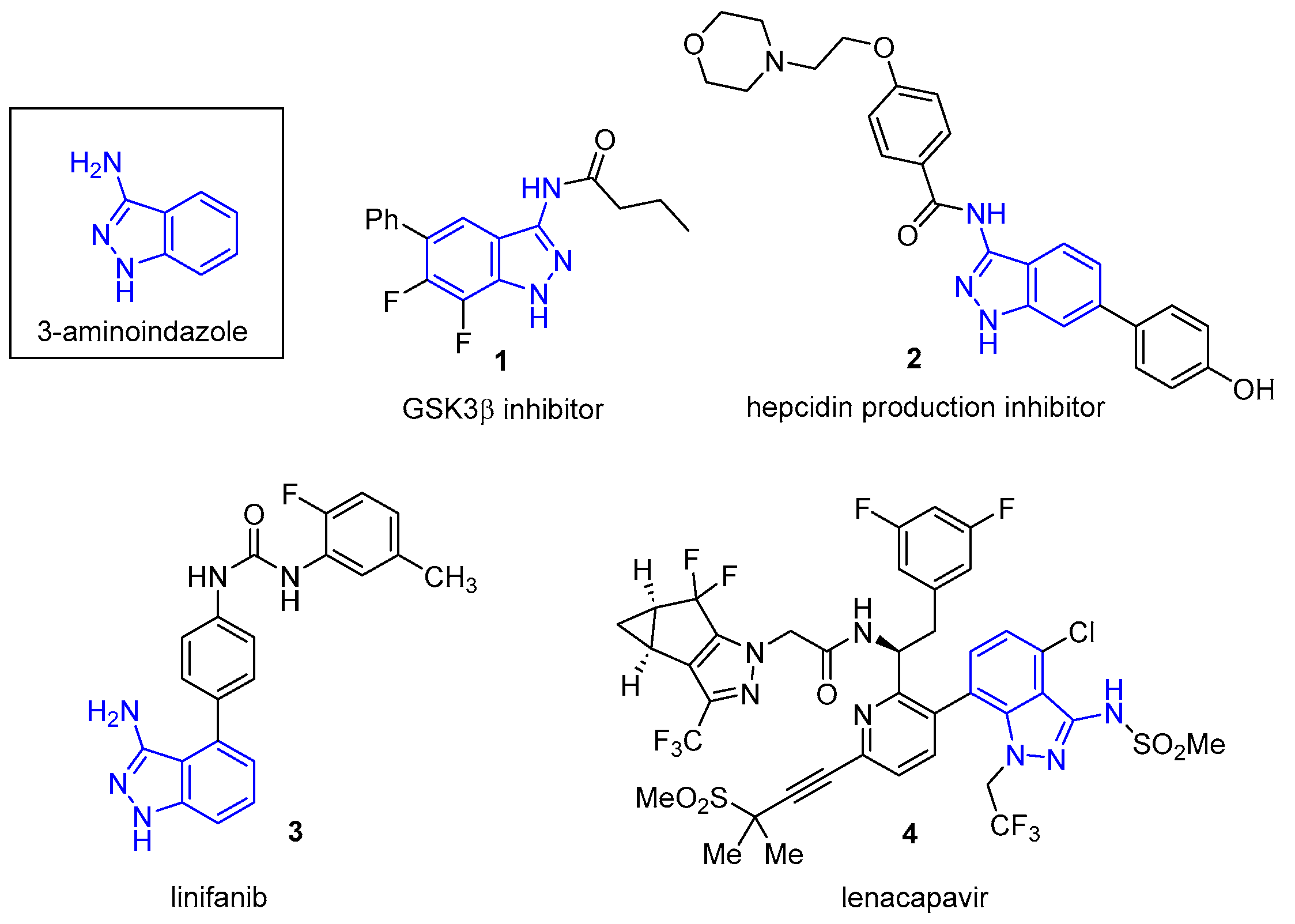
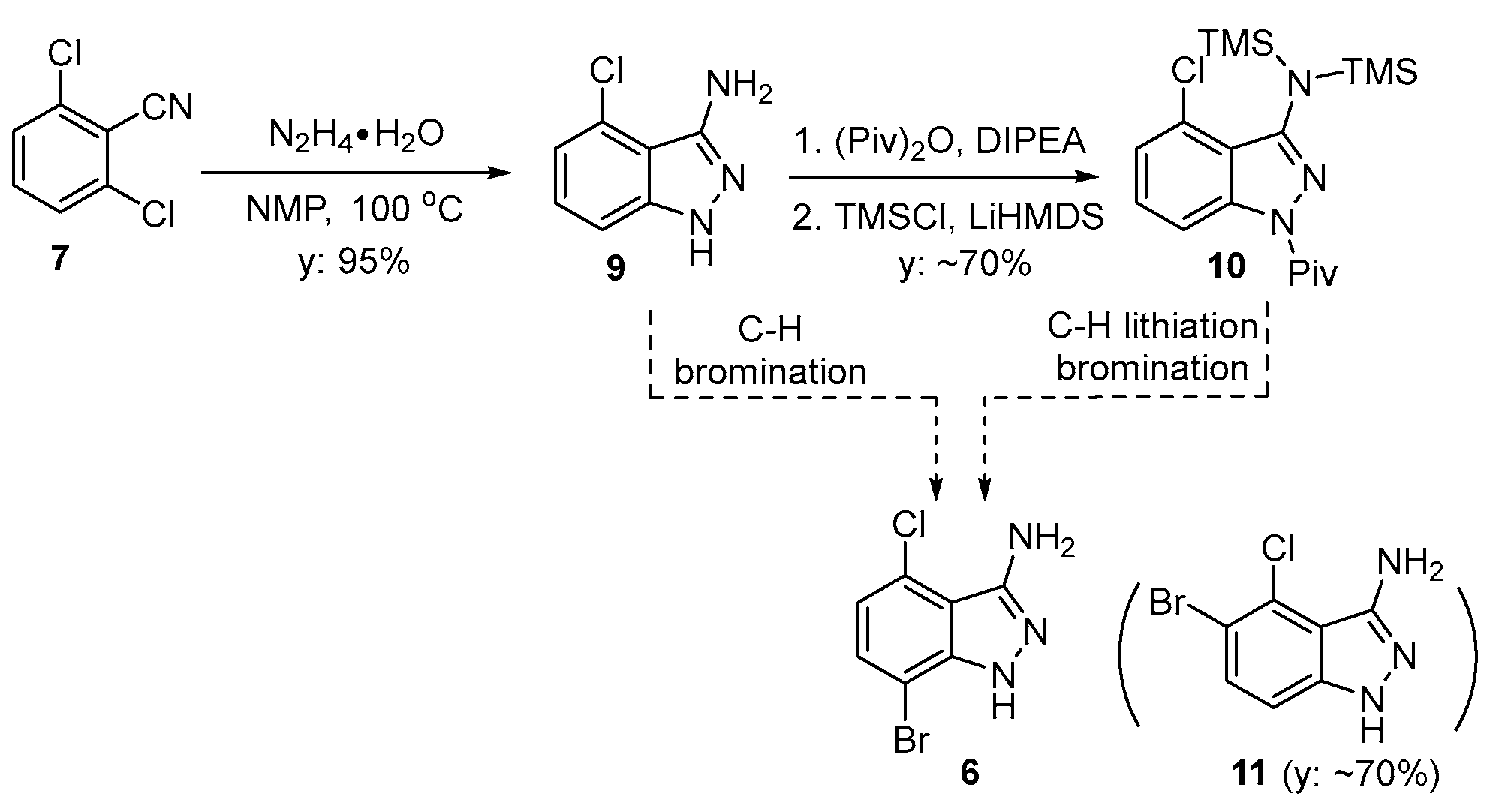

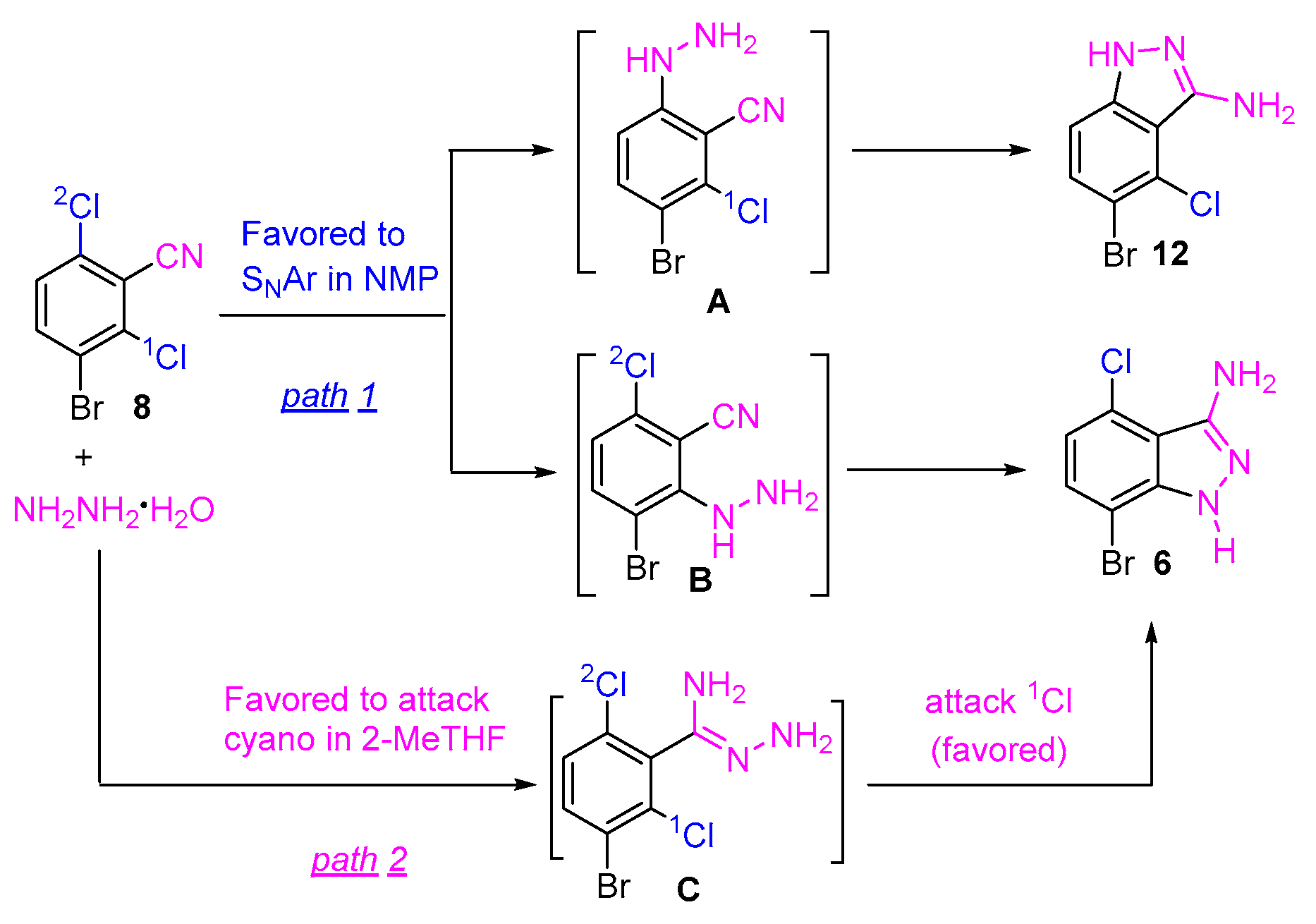
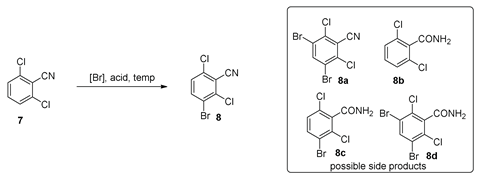 | |||||||||
|---|---|---|---|---|---|---|---|---|---|
| Entry a | [Br] (eq.) | Acid (eq.) | Temp (°C) | GCMS Analysis (TIC A%) c | |||||
| 7 | 8 | 8a | 8b | 8c | 8d | ||||
| 1 b | Br2 (2) | 96% H2SO4 (10) | 25 | 72 | - | - | 28 | - | - |
| 2 b | Br2 (2) | 96% H2SO4 (10) | 60 | 4 | - | - | 96 | - | - |
| 3 b | Br2 (2) | 96% H2SO4 (10) | 100 | 3 | - | - | 97 | - | - |
| 4 b | NBS (1.2) | 96% H2SO4 (10) | 25 | 12 | 75 | 12 | - | - | - |
| 5 b | NBS (1.2) | 96% H2SO4 (10) | 60 | 0.5 | 0.5 | 5 | - | 66 | 28 |
| 6 b | NBS (1.2) | 96% H2SO4 (10) | 100 | - | - | 4 | - | 61 | 32 |
| 7 | NBS (1.07) | 96% H2SO4 (10) | 25 | 3 | 93 | 4 | - | - | - |
| 8 | NBS (1.07) | 96% H2SO4 (5) | 25 | 21 | 70 | 9 | - | - | - |
| 9 | NBS (1.07) | 96% H2SO4 (9) | 25 | 7 | 92 | - | - | - | - |
| 10 | NBS (1.07) | 96% H2SO4 (11) | 25 | 2 | 94 | 4 | - | - | - |
| 11 | NBS (1.07) | 60% H2SO4 (10) | 25 | >95 | - | - | - | - | - |
| 12 | NBS (1.07) | 80% H2SO4 (10) | 25 | 14 | 66 | 20 | - | - | - |
| 13 | NBS (1.07) | TFA (10) | 60 | >95 | - | - | - | - | - |
| 14 | NBS (1.07) | Acetic acid (10) | 60 | >95 | - | - | - | - | - |
| 15 d | NBS (1.07) | 96% H2SO4 (10) | 25 | 4 | 93 | 3 | - | - | - |
| 16 e | NBS (1.07) | 96% H2SO4 (10) | 25 | 5 | 91 | 4 | - | - | - |
| 17 f | NBS (1.07) | 96% H2SO4 (10) | 25 | 5 | 91 | 4 | - | - | - |
 | |||||
|---|---|---|---|---|---|
| Entry a | Solvent | Temp (°C) | Eq. of NH2NH2·H2O | Conversion (%) b | Ratio c |
| 6:12 | |||||
| 1 | NMP | 60 | 2 | 100 | ~50:50 |
| 2 | DMSO | 60 | 2 | 100 | ~50:50 |
| 3 | EtOH | 95 | 10 | 100 | 65:35 |
| 4 | IPA | 95 | 10 | 100 | 70:30 |
| 5 | DIPEA | 95 | 10 | 100 | 75:25 |
| 6 | Pyridine | 95 | 10 | 100 | 68:32 |
| 7 | THF | 95 | 10 | 100 | 70:30 |
| 8 | Diglyme | 95 | 10 | 100 | 70:30 |
| 9 | 2-MeTHF | 95 | 10 | 100 | 73:27 |
| 10 | 2-MeTHF | 95 | 8 | 100 | 70:30 |
| 11 | 2-MeTHF | 95 | 4 | 98 | 70:30 |
| 12 d | 2-MeTHF | 95 | 4 | 99 | 70:30 |
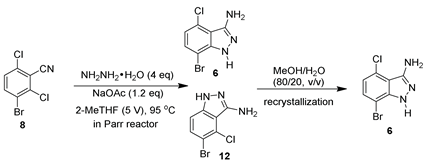 | ||||||
|---|---|---|---|---|---|---|
| Entry a | Reaction Scale | A% (GCMS (TIC)) of Crude b | 6 after Crystallization c | |||
| 8 | 12 | 6 | Purity by GCMS (TIC A%) | Isolated Yield | ||
| 1 | 20 g | 2 | 28 | 70 | 97 d | 50% |
| 2 | 40 g | <1 | 29 | 70 | 98 e | 56% |
| 3 | 80 g | <1 | 29 | 70 | 96 f | 53% |
Disclaimer/Publisher’s Note: The statements, opinions and data contained in all publications are solely those of the individual author(s) and contributor(s) and not of MDPI and/or the editor(s). MDPI and/or the editor(s) disclaim responsibility for any injury to people or property resulting from any ideas, methods, instructions or products referred to in the content. |
© 2024 by the authors. Licensee MDPI, Basel, Switzerland. This article is an open access article distributed under the terms and conditions of the Creative Commons Attribution (CC BY) license (https://creativecommons.org/licenses/by/4.0/).
Share and Cite
Asad, N.; Lyons, M.; Muniz Machado Rodrigues, S.; Burns, J.M.; Roper, T.D.; Laidlaw, G.M.; Ahmad, S.; Gupton, B.F.; Klumpp, D.; Jin, L. Practical Synthesis of 7-Bromo-4-chloro-1H-indazol-3-amine: An Important Intermediate to Lenacapavir. Molecules 2024, 29, 2705. https://doi.org/10.3390/molecules29122705
Asad N, Lyons M, Muniz Machado Rodrigues S, Burns JM, Roper TD, Laidlaw GM, Ahmad S, Gupton BF, Klumpp D, Jin L. Practical Synthesis of 7-Bromo-4-chloro-1H-indazol-3-amine: An Important Intermediate to Lenacapavir. Molecules. 2024; 29(12):2705. https://doi.org/10.3390/molecules29122705
Chicago/Turabian StyleAsad, Naeem, Michael Lyons, Shirley Muniz Machado Rodrigues, Justina M. Burns, Thomas D. Roper, G. Michael Laidlaw, Saeed Ahmad, B. Frank Gupton, Douglas Klumpp, and Limei Jin. 2024. "Practical Synthesis of 7-Bromo-4-chloro-1H-indazol-3-amine: An Important Intermediate to Lenacapavir" Molecules 29, no. 12: 2705. https://doi.org/10.3390/molecules29122705






